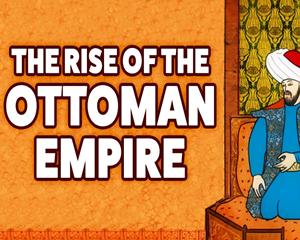(单词翻译:单击)
In the late 13th century, Osman I established a small beylik, or principality, in what is now Turkey.
13世纪末,奥斯曼一世在如今的土耳其建立了一个小辖区,或称之为公国。
In just a few generations, this beylik outmaneuvered more powerful neighbors to become the vast Ottoman empire. What enabled its rapid rise?
仅仅几代之后,这个小辖区运筹帷幄,战胜了更为强大的邻国发展成为伟大的奥斯曼帝国。它是因何而得以快速崛起的呢?
In Osman's time, the Anatolian peninsula was a patchwork of Turkic principalities sandwiched between a crumbling Byzantine Empire and weakened Sultanate of the Seljuk of Rum.
在奥斯曼时代,安纳托利亚半岛上只是散布着一些土耳其的公国,夹在摇摇欲坠的拜占庭帝国和辉煌不再的罗姆苏丹国之间。
Osman quickly expanded this territory through a mixture of strategic political alliances and military conflicts with these neighbors,
奥斯曼通过建立战略政治同盟以及对周边邻国进行军事打击,实现了领地的快速扩张,
attracting mercenaries first with the promise of booty, then later through his reputation for winning.
先是靠利诱吸引到一批雇佣兵,后来则是依靠他战无不胜的威名。
Osman was the first in a line of Ottoman rulers distinguished by their political shrewdness.
在一众精明的奥斯曼土耳其统治者中,奥斯曼本人出类拔萃。
Often prioritizing political and military utility over ethnic or religious affinity,
对这些政客们来说,政治军事效用比种族和宗教亲缘更为重要,
they expanded their influence by fighting along certain sides when needed, and fighting against them when the time was right.
他们奉行着有利则并肩作战,时机成熟亦可反而为敌的政策,不断扩大着自身的影响力。
After Osman's death his son Orhan established a sophisticated military organization and tax collection system geared towards funding quick territorial expansion.
奥斯曼死后,他的儿子奥尔汗创建了先进的军事组织和税收体系,为急速的领土扩张备好了资金。
The Ottomans' first major expansion was in the Balkans, in southeast Europe.
奥斯曼帝国第一次大扩张发生在欧洲东南部的巴尔干半岛。
The military employed a mixture of Turkic warriors and Byzantine and other Balkan Christian converts.
军队由土耳其勇士、拜占庭人和巴尔干基督教信徒组成。
They captured thousands of young Christian boys from villages from across the Balkans, converted them to Islam,
他们俘虏了上千个来自巴尔干半岛各个村镇的基督教男孩,迫使他们改信伊斯兰教,
and trained them to become the backbone of a fierce military elite force known as the Janissaries.
并把他们训练成凶猛的军事精英队伍的中坚力量,也就是人们所知的禁卫军。
The captured enslaved boys could rise to the high position of a vizier in the Ottoman government.
这些被俘虏做奴隶的男孩可以一路高升到维齐尔的位置,即奥斯曼政府的国家高官。
Rulers of conquered areas were also allowed, even encouraged, to convert to Islam and take positions in the Ottoman government.
被征服地的统治者们也被允许,甚至被怂恿转而信奉伊斯兰教,并在奥斯曼政府中任职。
Meanwhile, non-Muslims who belonged to Abrahamic religions were allowed religious freedom in exchange for a tax known as Jizye,
另外,属于亚伯拉罕诸教的非穆斯林能够保有宗教自由,但作为交换,他们需要上缴一种叫做吉兹亚的人头税,
among other strict conditions -- for example, they were not allowed to join the army.
此外,还要遭受其他严格限制--比如,他们不可以参军。

By the end of the 14th century, the Ottomans had conquered or subordinated most of the Anatolian beyliks as well as the Balkans.
14世纪末期,大部分安纳托利亚公国及巴尔干半岛国家,已经或臣服或附属于奥斯曼帝国。
But in the first half of the 15th century, as Sultan Beyazit I focused on Western expansion, the Central Asian ruler Timur attacked from the east.
但在15世纪上半叶,当苏丹王巴耶塞特一世致力于向西方扩张之时,中亚统治者帖木儿从东面发起了进攻。
He captured Beyazit and carted him off in an iron cage, sparking a ten year struggle for succession that almost destroyed the Ottoman empire.
他俘虏了巴耶塞特,并把他关押在铁笼子里,这一事件引发了长达十年的王位争夺战,几乎摧毁了奥斯曼帝国。
Sultan Murad II turned this trend around, but fell short of one of his loftiest goals: capturing the Byzantine capital, Constantinople.
苏丹王穆拉德二世力挽狂澜但他的崇高目标之一:占领拜占庭首都君士坦丁堡,却以失败告终。
His son, Sultan Mehmed II, or Mehmed the Conqueror, vowed to succeed where his father had failed.
他的儿子,苏丹王穆罕默德二世,又被称为征服者穆罕默德,发誓要实现父亲未竟的宏愿。
In preparation for the attack on Constantinople, he hired a Hungarian engineer to forge the largest cannon in the world,
在进攻君士坦丁堡的准备阶段,他雇用了一位匈牙利工程师,来锻造世界上最大的大炮,
used Serbian miners to dig tunnels under the walls of the city, and ordered his fleet of ships to be carried overland, attacking the city from an unexpected direction.
让塞尔维亚矿工在城墙下挖掘隧道,并命令舰队经由陆路,从出人意料的方向攻城。
He laid siege to the city and in the spring of 1453, Constantinople fell to the Ottomans.
他的军队包围了这座城市,于是在1453年春,君士坦丁堡落入奥斯曼人之手。
It would become the Ottoman capital, known by its common Greek name, Istanbul, meaning "to the city."
这座城市后来成为了奥斯曼帝国的首都,它更为人所知的希腊语名字伊斯坦布尔,意思是“进城去”。
By the time Mehmed II conquered Constantinople, the city was a shadow of its former glory.
穆罕默德二世占领君士坦丁堡之时,这座城市早已不复往日的辉煌。
Under Ottoman rule, it flourished once again.
但在奥斯曼帝国统治下,它又重现昔日繁荣。
On an average day in Istanbul, you could hear people speaking Greek, Turkish, Armenian, Persian, Arabic, Bulgarian, Albanian, and Serbian.
在伊斯坦布尔普通的一天,你能听到人们说着希腊语、土耳其语、亚美尼亚语、波斯语、阿拉伯语、保加利亚语、阿尔巴尼亚语和塞尔维亚语。
Architects like the famous Sinan filled the city with splendid mosques and other buildings commissioned by the sultans.
建筑师们如著名的锡南,受苏丹王委任,用壮丽的清真寺和其它建筑丰富着这座城市。
Through Istanbul, the Otttomans brought commodities like coffee to Europe.
经由伊斯坦布尔,奥斯曼人将咖啡等货物带到了欧洲。
They entered a golden age of economic growth, territorial acquisition, art and architecture.
他们进入了经济增长、领土扩张、艺术和建筑蓬勃发展的黄金时期。
They brought together craftspeople from across Europe, Africa, the Middle East and Central Asia to create a unique blend of cultural innovation.
他们将欧洲、非洲、中东和中亚的手工匠人们聚到一起,创造出独特的文化创新融合。
Iznik ceramics, for example, were made using techniques from China's Ming dynasty, reimagined with Ottoman motifs.
比如伊兹尼克陶瓷,既运用了中国明代的技法,又基于奥斯曼图案进行了二次创作。
The Ottomans would continue to expand, cementing their political influence and lucrative trade routes.
奥斯曼人继续扩张,巩固其政治影响力和获利颇丰的贸易路线。
The empire lasted for more than 600 years and, at its peak, stretched from Hungary to the Persian Gulf, from the Horn of Africa to the Crimean Peninsula.
奥斯曼帝国延续了600多年,在其鼎盛时期,领土范围由匈牙利绵延到波斯湾,从非洲角一直到克里米亚半岛。


